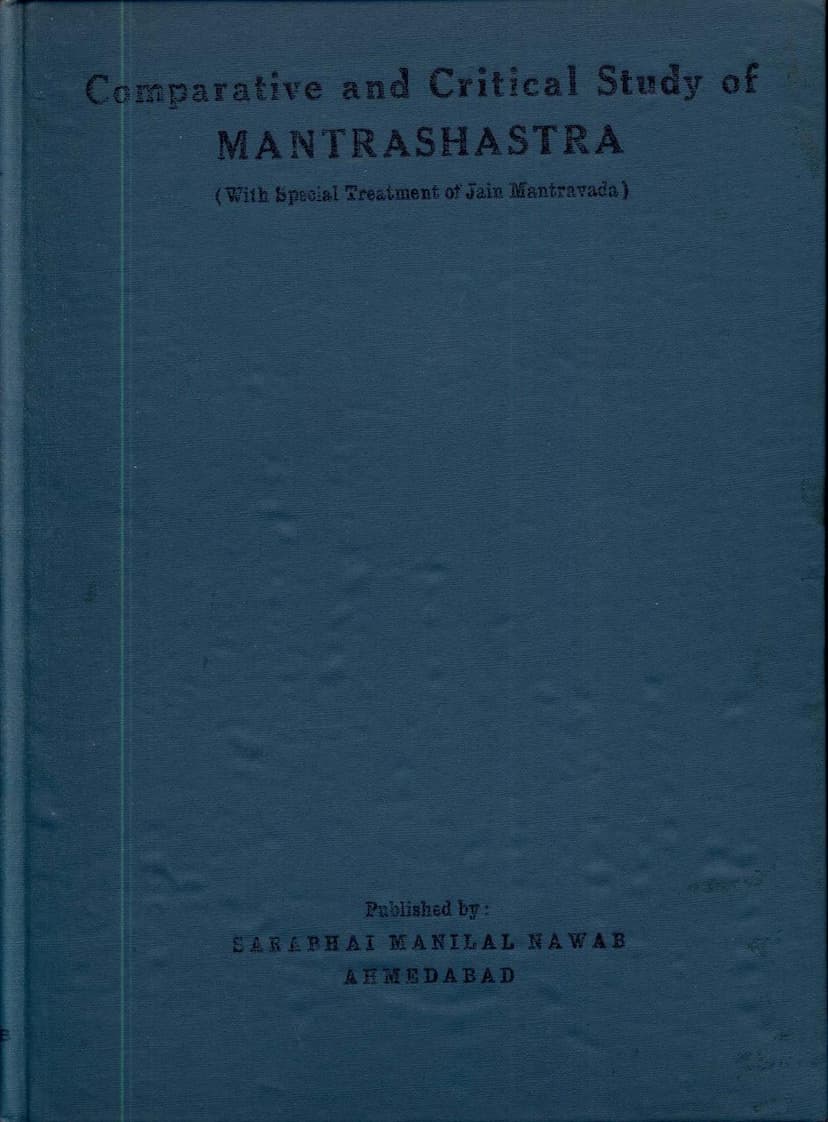Comparative And Critical Study Of Mantrashastra
Added to library: September 1, 2025

Summary
This comprehensive Jain text, "Comparative and Critical Study of Mantrashastra (With Special Treatment of Jain Mantravada)," authored by Mohanlal Bhagwandas Jhaveri and K. V. Abhayankar, and published by Sarabhai Manilal Nawab in Ahmedabad in 1944 AD, serves as an in-depth exploration of the science of mantras, magic, and occult practices, with a particular focus on their manifestation within Jainism.
The book begins by establishing the broader context of mantra śāstra, delving into the nature of magic and magical symbolism, the power of thought (thought-force), and the burgeoning field of new psychology that acknowledges the potency of the mind and consciousness. It discusses concepts like mentative energy, telepathy, clairvoyance, the subconscious and super-conscious mind, contemplation, colors, emotions, and the human aura, attempting to bridge ancient beliefs with emerging scientific and psychological understanding.
The author then meticulously examines the concept of mantras across various traditions, including:
- Mantras in General: How mantras act, citing Western writers and the Tantric view, including the theory that mantras are pure thought-forms and divine manifestations.
- Kundalini Shakti: Explaining its role in Yoga, its connection to Shabda Brahman, chakras, samadhi, and liberation.
- Tantras: Critically analyzing Tantras, addressing Western misconceptions, highlighting the necessity of practical methods in religion, the utility of ritual, and the contents and characteristics of Tantras, including their antiquity, schools, and common practices. It also touches upon the controversial Panchatattva worship and Jain and Buddhist influences on Tantrism.
- Tantrik Sadhana: Detailing the aims and means, the importance of the Guru and Diksha, common elements, psychological principles, various types of worship (Pūjā), preliminary rites, the purpose of different rituals, places and times for worship, seats and postures, rosaries, purification processes (Bhutaśuddhi, Nyasa), contemplation (Dhyana), recitation (Japa), sacrificial rites (Homa, Tarpana), the attainment of Siddhis, and concluding with Mahāpūjā.
- Mantrayana, Vajrayana, and Tantrism amongst Buddhists: Exploring the development of Tantric Buddhism, its core tenets, and the influence of figures like Padma Sambhava and Nāgārjuna.
- Mysticism of Darvishes: Providing a comparative study of Sufism and Darvish orders in India, their religious practices, spiritual powers, and mystical concepts like Murāqabah, Insilā, and Tawajjuh, drawing parallels with Yoga.
- Jain Mantravada and Caityavāsis: This section forms the core of the book's special treatment. It traces the antiquity of Jain mantras and mantric literature, linking it to Sri Pārśvanātha and the Pūrva literature. It discusses the historical context of Jainism, the role of various Acharyas, the popularity of Sri Pārśvanātha and his attendant deities like Padmavati, the concept of Vidyadharas, and the rise of Caityavāsis. The text delves into specific Jain mantras and Vidyas, such as the Pañcaparameṣṭi Mantra, Vardhamāna Vidyā, Sūrimantra, and the significance of Siddhacakra. It analyzes the works of prominent Jain Mantrikas from ancient times up to the modern era, including Sri Vajraswāmi, Kālakācārya, Aryakhaputācārya, Yasobhadrasūri, Hemacandrācārya, Jinadattasūri, Jinakusalasūri, Jinacandrasūri, and the author himself, Muni Mohanlalji. The work also explores the debate regarding the priority of Jain or Buddhist Tantras and the integral nature of mantras and vidyas within the broader Jain philosophical framework, emphasizing their role in spiritual upliftment and ultimate salvation when practiced with the right intention.
- Antiquity of Jain Mantras and Mantric Literature: This extensive section provides detailed historical and scriptural evidence for mantras and vidyas in Jainism, tracing their origins back to the Pūrvas, Sri Pārśvanātha, and even Sri Rṣabhadeva. It examines popular Jain deities associated with Mantravāda like Sarasvati, Ambikā, Padmāvatī, and Cakreśvarī, and discusses their worship and iconography. The text references various Jain texts like Vasudevahindi, Sūyagadānga, Acaranga, Uttarādhyayana, Nisitha Sutra, Vyavahāra Sutra, Pañcaparameṣṭi Mantra, and Kalpasūtras to establish the prevalence and integral nature of mantric practices.
- Parsis and Mantras: Briefly touching upon the Zoroastrian belief system, the author discusses the Amesha-Spentas, Yazatas, the cult of Mithra, Fravashis, principal doctrines, and the Vedic connection, highlighting the Parsi reverence for sacred prayers like Ahuna Vairya, Ashem Vohu, and Yenghe Hatām, which they consider analogous to mantras.
The Appendices provide further detailed information on specific Kalpas, Stotras, and Mantras related to Padmāvati, Sarasvati, Ambikā, Cakreśvarī, and the Sūrimantra, as well as discussions on the priority between Yogaśāstra and Jñānārṇava and the author's own extensive list of Mantrakalpas.
Overall, "Comparative and Critical Study of Mantrashastra" is a monumental work that aims to systematically analyze and present the vast and complex subject of mantrashastra from a comparative perspective, with a strong emphasis on its rich tradition within Jainism. It seeks to illuminate the interconnectedness of various spiritual and occult practices across different religious traditions while firmly rooting the discussion in Jain philosophy and history.